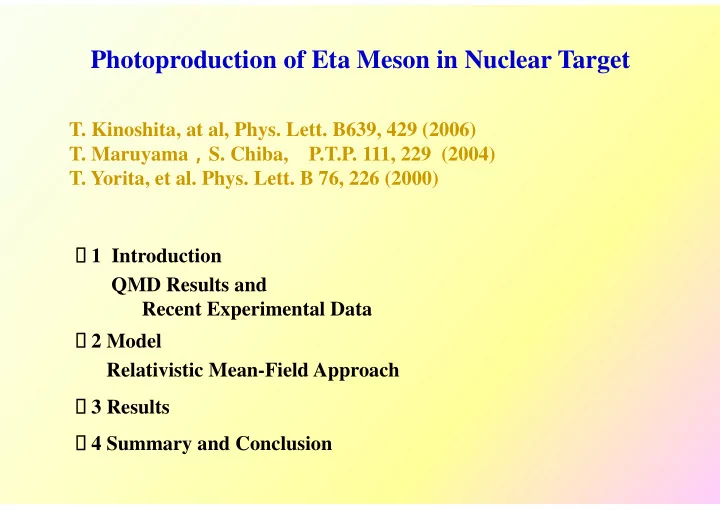

Photoproduction of Eta Meson in Nuclear Target T. Kinoshita, at al, Phys. Lett. B639, 429 (2006) T. Maruyama , S. Chiba, P.T.P. 111, 229 (2004) T. Yorita, et al. Phys. Lett. B 76, 226 (2000) § 1 Introduction QMD Results and Recent Experimental Data § 2 Model Relativistic Mean-Field Approach § 3 Results § 4 Summary and Conclusion
§ 1 Introduction Reactions with Lepton : Probes Electron Scattering & Photo Reaction Purpose : Information of Nuclear Curren t Γ photon absorption process Information ⇒ Pure but Insufficient Amount Inclusive Reaction Exclusive Reaction ⇒ Large Amount but Impure → Final State Interaction Collisional Processes of Observed Particles Semi-Classical Numerical Simulation BUU, QMD
Quantum Molecular Dynamics ( QMD ) 1 ) Single Events Semi-Classica Numerical Simulations 2 ) Classical Motions of Particles 3 ) Two Bosy Collionss ← Experimental Data Inelastic Collisions : N +N⇔ N + Δ ( N * ) Particle Decays : Δ ( N * )⇔ N + π 4) Describing Multi-Step Processes 5) Possible to Give Coincident Observables ( p, π ) 6) Applicable to various Kinds of Reaction Photoreactions starting simulations at gamma-ray absorptted
Photoreaction Total photoabsorption on nuclei Total Photoabsorption Cross-Section ⇒ N * - Resonance Peaks disappear Medium Properties for N* Resonance ? Widths of D13(1520) and F15(1680) are broadened? How about other S11(1535) ?
§ 2 QMD Model QMD = A-Body Classical Motion + 2-Body Collisions 1 ( ) / 4 x r L 2 i p x e ( 1 , , ) ( ), ( ) x x x x i i 1) Wave Function A i i i 2 3 / 2 ( 2 ) L i 2) Classical Motion Parts (Mean-Field Parts) H H dr dp QMD QMD i , i , ( , ; , ) | | H r r p p H 1 1 QMD A A dt p dt r i i Elastic Collisons 3) 2-Body Collisions + Pauli Blocking N + N ⇔ N + N Inelastic Collisons N + N ⇔ N + R (R + R) 4 ) Statistical Decay
Initial Distribution 2 Body Col & Isobar Decay Elastic Collisions A nucleon absorps photon N + N ↔ N+R, R+R γ + N → Δ, N* R ↔ N + π(η) Classical Motions by mean-field H H dr dp Statistical Decay QMD QMD i i , dt p dt r i i Final Distribution
0 . 67 n p
Analysis of QMD for 12 C T.Yorita, et al., Phys. Lett.B476 (2000) 226 210 MeV 0 150 MeV 0 KEK-Tanashi 63 Cu 27 Al 12 C
§ 3 RMF approach T.Maruyama & S. Chiba, PTP 111 (2004) 229 RMF approach : two kinds of Dirac Mean-Fileds U s : attractive Scalar Fields U μ : repulsive Vector Fields In-medium Properties for Nucleon are quite different from that in vacuum If in-medium corrections for N* are not so big, …. ? N* (vacuum) → N (medium) : big medium effects are seen ? unbound bound ( *) ( ) , 0 U N c U N s N*– mean-fields
N*-width in Medium : Function of Phase Space p s p eff 2 2 1 ( ) k k k dp n p i i i 2 p E R p p * 2 ( ) s p q eff
BUU calculations J. Lehr, M. Post, U. Mosel, Phys. Rev. C68 (2003) 044601 non-rela. calculation with Momentum-Dependent Potential N* ( high p weak pot. ) N ( low p, deep pot. )
§4 Q M D C a l c u l a t i o n s s U eff N N*(unbound) → N (bound) Peak shift
Jaegle et al., Proc. of NSTAR05 Exp. : γ + D → πη a new production process in high energy photon πη
Comparison with QMD ( *) ( ) U N U N
§ 5 Summary Numerical Simulation Approaches fot Nuclear Reaction (BUU, QMD) are useful for study of Photoreaction Analyzing Final State Interaction γ + C, Cu → η + X No dramatic results Elementary Process γ +N → η + X , γ +N → πη +X U (S11) ≈ U (N) Future η + Nucleus Bound State Applying QMD to neutrino Reaction In-Medium Form Factor M.K.Cheoun, K.C.Kim, K.Saito, T.Kajino, K.Tsushima, T.M., PRC, #065502 (13) M.K. Cheoun, K.S.Kim, H. Kim,W.Y. So, T.M.and T.Kajino, J.Phys.G (2014) in press
Neutrino Reaction ( 500 MeV ) C Neutra Current Contribution Exp: MiniNOONE M.K. Cheoun,et al. J.Phys.G (14) in press
Collision Broadening: L.A.Condratyuk, N.P. A579 (1994) 453 Γ(In -Med.) = Γ(vac) + Γ coll N* + N → N + N
Pionphotoproduction and N*
Widthes of D 13 (1520) and F 15 (1680) are broadened? How about other N* Isobars? D 13 (1520) and F 15 (1680) Decay Processes are too Complicated * N N N N S 11 (1535) Decay Process is Simple * N N N KEK-Tanashi Experimets : γ + A → η+ X Information of S11 Isobar Resonances QMD Analysis (Yorita et al.) Theory ⇔ Ecperimet Width Γ(S 11 ) = Elementary Γ(S 11 ) = 150MeV Not Good 150MeV Width Γ(S 11 ) = 212MeV Good
Recommend
More recommend